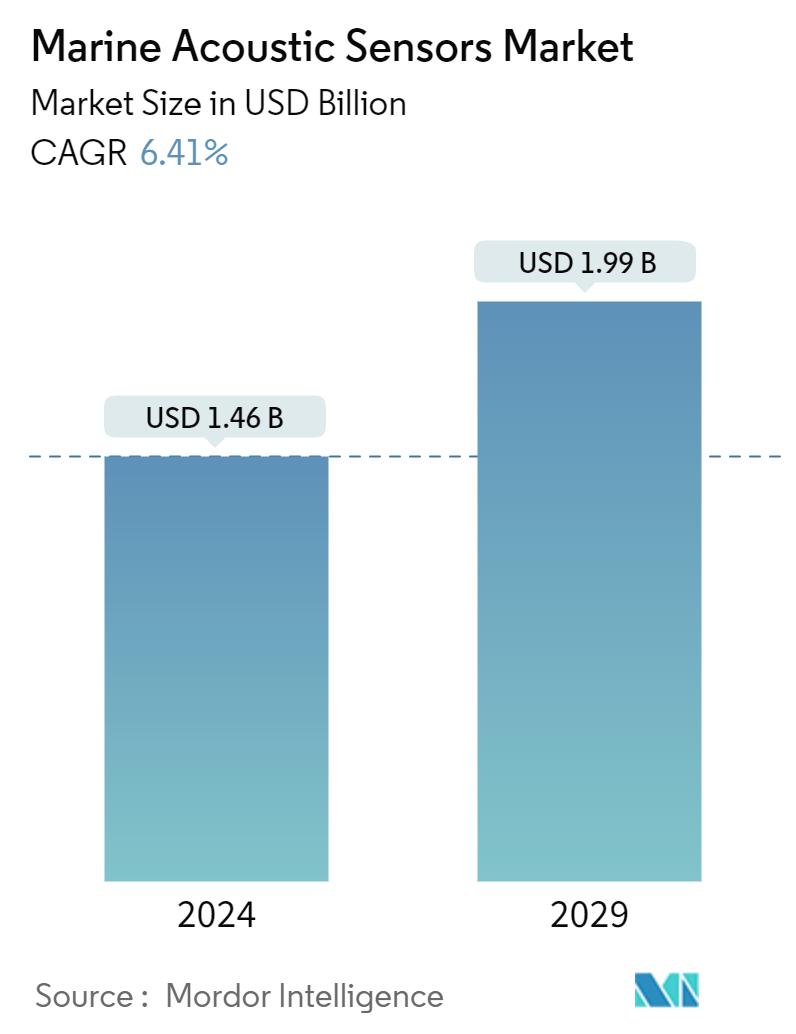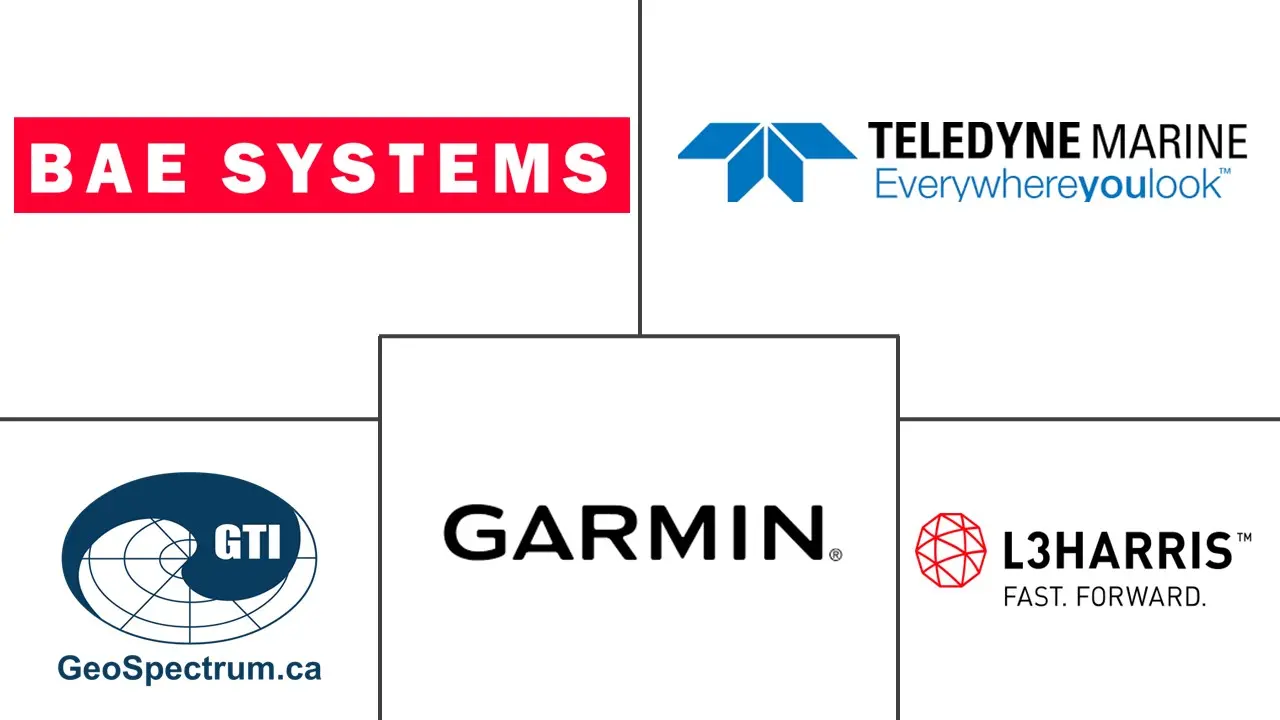Market Size of Marine Acoustic Sensors Industry

| Study Period | 2019 - 2029 |
| Market Size (2024) | USD 1.46 Billion |
| Market Size (2029) | USD 1.99 Billion |
| CAGR (2024 - 2029) | 6.41 % |
| Fastest Growing Market | Asia Pacific |
| Largest Market | North America |
| Market Concentration | Low |
Major Players
*Disclaimer: Major Players sorted in no particular order |
Marine Acoustic Sensors Market Analysis
The Marine Acoustic Sensors Market size is estimated at USD 1.46 billion in 2024, and is expected to reach USD 1.99 billion by 2029, growing at a CAGR of 6.41% during the forecast period (2024-2029).
Marine acoustic sensors are used in small devices in various ship types for real-time data collection and environmental monitoring. These devices come in a broad variety of forms with numerous uses. Marine acoustic sensors are used for marine life detection, monitoring, and other purposes.
- The Internet of Things (IoT) technology has been presented as a recent intelligent work technical revolution concept. The marine industry will have access to a broad range of opportunities due to the rapidly increasing rush of acoustic sensor technology applications and the capabilities of low-cost computing components.
- Docks are being supported globally in solitary networks to support their cloud-based IoT due to the rapid adoption of IoT in global marine technology. An intelligent and smart port can be described as fully automated, with all devices connected via an IoT smart port. It comprises a network of intelligent sensors, including acoustic sensors and wireless devices that make the central infrastructure of a smart port.
- The rising technological-based acoustic sensors for military ships, submarines, and vessels to guard and give them real-time situational awareness are boosting the market growth during the forecast period.
- The marine acoustic sensors allow the integration of signal processing and sensor functions within one product. However, acoustic sensors have faced operational challenges like inadequate stability and reliability, impacting their adoption growth.
- Increased investments in R&D activities by leading shipbuilders and system developers globally for expanding fully autonomous ships have increased the need for marine acoustic sensors. Autonomous ships are estimated to launch as sustainable, safe, and efficient modes of process for the marine industry.
Marine Acoustic Sensors Industry Segmentation
Acoustic sensors are a division of micro-electromechanical systems that work on the theory of modulating surface acoustic waves that sense physical phenomena. They are used to convert electrical signals into mechanical waves. They are used in various fields, such as signal processing and sensing in marine applications.
The market size is evaluated by analyzing various products, such as hydrophones, underwater transducers, acoustic towed arrays, and side-scan sonar, considered in regions such as North America, Europe, Asia Pacific, Latin America, the Middle East, and Africa. The market sizes and forecasts are provided in terms of value in USD for all the above segments. The competitive landscape has been considered to calculate the penetration of marine acoustic sensors and how players involve themselves in organic and inorganic growth strategies. Companies continuously innovate products to increase their market share and profitability. The market study also focuses on the impact of key macro trends on the market ecosystem.
| By Product | |
| Hydrophones | |
| Underwater Transducer | |
| Acoustic Towed Array | |
| Side-scan Sonar |
| By Geography*** | |
| North America | |
| Europe | |
| Asia | |
| Australia and New Zealand | |
| Latin America |
Marine Acoustic Sensors Market Size Summary
The marine acoustic sensors market is poised for significant growth, driven by the increasing integration of IoT technologies and the demand for advanced monitoring solutions in the marine industry. These sensors, essential for real-time data collection and environmental monitoring, are becoming integral to the development of smart ports and autonomous vessels. The market is experiencing a surge in applications for military and defense purposes, where acoustic sensors are crucial for enhancing situational awareness and operational efficiency. Despite challenges related to stability and reliability, ongoing investments in research and development by leading shipbuilders and system developers are fostering innovation and expanding the adoption of these technologies.
The underwater communication systems market is also witnessing robust growth, particularly in North America, due to the rising use of autonomous underwater vehicles and the increasing need for scientific exploration. The US Navy's accelerated acquisition strategies and significant investments in advanced manufacturing technologies underscore the strategic importance of underwater communication systems. The market is characterized by a fragmented landscape with key players like BAE Systems, Garmin, and Teledyne Marine Technologies, who are actively pursuing partnerships and acquisitions to enhance their offerings. Recent collaborations and technological advancements, such as the deployment of autonomous underwater vehicles and the development of predictive algorithms for marine mammal protection, highlight the dynamic nature of the market and its potential for further expansion.
Marine Acoustic Sensors Market Size - Table of Contents
-
1. MARKET OVERVIEW
-
2. MARKET SEGMENTATION
-
2.1 By Product
-
2.1.1 Hydrophones
-
2.1.2 Underwater Transducer
-
2.1.3 Acoustic Towed Array
-
2.1.4 Side-scan Sonar
-
-
2.2 By Geography***
-
2.2.1 North America
-
2.2.2 Europe
-
2.2.3 Asia
-
2.2.4 Australia and New Zealand
-
2.2.5 Latin America
-
-
Marine Acoustic Sensors Market Size FAQs
How big is the Marine Acoustic Sensors Market?
The Marine Acoustic Sensors Market size is expected to reach USD 1.46 billion in 2024 and grow at a CAGR of 6.41% to reach USD 1.99 billion by 2029.
What is the current Marine Acoustic Sensors Market size?
In 2024, the Marine Acoustic Sensors Market size is expected to reach USD 1.46 billion.

